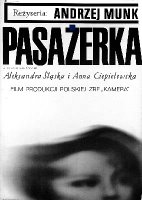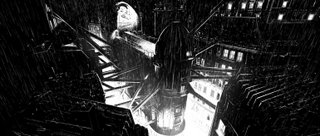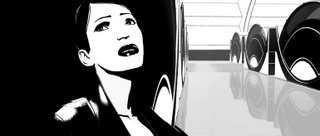Polish director, Andrzej Munk, died in a car accident in 1961, before completion of this film. Remaining footage and production stills were stitched together by Witold Lesiewicz in the most respectful manner, like an archeologist discovering a lost reel who puts it all together and investigates so to make sense of what could have been the final film envisioned by its director.
Like for other famous reconstructed films (Que Viva Mexico!, Bezhin Meadow or It's All True) the result is a "meta-film", a film describing itself, a new film beyond the original film.
Eisenstein's Que Viva Mexico! (1932-79)
The american production of this epic silent documentary was interrupted by the Great Depression, the stock footage had been long shelved unedited at the MoMA. 47 years later, co-director Grigori Aleksandrov restored the film with narrative guidelines and a "making of" commentary, plus sound effects. The main fiction story involving a villager uprising against the tyranic landowners is easy to follow, but some interludes are lacking coherence, like the death carnival folklore, that become an abstract montage of dynamic compositions. Without the sophisticated "propaganda" of Eisenstein's final cut, we are left with another kind of film, one that is less didactic and more poetical, summoning interrogations (on the value of images) instead of self-conscious plot.
Eisenstein's Bezhin Meadow (1935-68)
Banned in 1937 by the Soviets, all prints were destroyed. Only production stills remain of this lost film, and were edited back in a slideshow with a commentary track by Sergei Yutkevich in 1968 according to Eisenstein's storyboard. The spare frames from Eisenstein's editing table, freeze each take at an awkward instant, although showing the powerful visual composition of his great cinematographer: Eduard Tisse. So this succession of random pictures from a lost film that we can no longer see, is like watching the original film through a stroboscopic projector. Quite an unfriendly way to follow a silent slide show despite the few titlecards, yet powerfully intriguing and riveting. The viewer's imagination must fill the gaps more so than with the conventional cinema ellipsis, and saves an extraordinary room to project our thoughts onto the potential film held back from our sight.
Orson Welles' It's All True (1942-93)
After a budget cut by the studio, the 3-fold documentary could never be finished/edited by Welles. 51 years later, Wilson (Director assistant), Krohn and Meisel edited the finished narrative segment "Four men on a raft", with the various documentary footage from the abandonned segments (the Rio carnival and a traditional veal christening). Four Men on a raft is already a fictionized adaptation of the extraordinary real-life journey of northern fishermen who became national heroes fighting for their rights, and one of them died during the reconstitution. Welles' own commentary on the debacle of his project and the end of the RKO adds another layer of meta-film, further put into perspective by Wilson's commentary of the reconstruction. Which fabricates a superimpression of 5 layers of reality at all time as we watch the film, our mind wandering from one to another, each layer interrogating the next one, which re-qualify the images depending on the perspective:
Real-world reality (Brazil history), reality of the (staged) documentary (Welles' vision), reality of the filmmaking (death of the actor, budget cut), aftermath hindsights (Welles' commentary), reconstruction (Wilson's commentary)
Thinking of it, Vérités et mensonges / F for Fake (1974) is also a meta-film, mixing reality and fiction, documentary and narration in an ambiguous riveting document disputing the credibility of real and forged images (but this time purposely meant that way and finalized by its auteur).
The meta-film (I'm not sure if this term is correct) is not quite a finished work, imperfect, truncated, elliptical. A posthumous glimpse at a work-in-progress, suspended in time for ever because we can only speculate on the auteur's final cut. What could have been modified on the set during the shooting of the missing scenes, or rearranged on the editing table?
This rare chance composes three films in one, a portion of traditional narrative fiction, the reconstruction making of and the sum of the two, an hybrid storytelling mixing fiction and reality for an experimental film where the failed project becomes a powerful device in another unforeseen drama.
Like F for Fake, Peter Jackson and Costa Botes did just that in the mockumentary Forgotten Silver (1995), although the lost reel and the reconstitution was only pretense. Knowing the interruption of the production in Pasazerka is not a plot device adds a metaphysical dimension to the experience of a regular fiction drama.
I'm especially excited by this exceptional opportunity to leave the audience with an underachieved film, as a "deconstruction happening". I'd argue the meta-film is almost more interesting than just another film, be it a supposed masterpiece, which Pasazerka could have very well been, up there with the best achievements of the Czech New Wave. This experimental reconstitution made of edited footage, still pictures and a multilayered narration (both the one of the fictional story and the one of the archeological investigation) produces a new kind of film that could hardly be factured intentionally. The real-life tragedy incorporates the fictional film all rolled up in one new entity. We venture in a surreal territory. And the production stills filling the blanks for the unshot scenes become a slideshow reminiscent of Chris Marker's La Jetée (1962).
Pasazerka / The passenger (1963/Andrzej Munk/Poland) ++++
 A German woman, Liza, onboard a luxury cruiseliner with her husband she married in an unspecified south american ("friendly") country, back to Europe for the first time since WW2, notices a familiar face on one of the passenger boarding the ship in England, last stop before the final destination on the continent. The cruiseliner is first described in a documentary fashion as an "island in time" where people are anonymous and social/cultural/professional backgrounds are put aside during the offshore lapse.
A German woman, Liza, onboard a luxury cruiseliner with her husband she married in an unspecified south american ("friendly") country, back to Europe for the first time since WW2, notices a familiar face on one of the passenger boarding the ship in England, last stop before the final destination on the continent. The cruiseliner is first described in a documentary fashion as an "island in time" where people are anonymous and social/cultural/professional backgrounds are put aside during the offshore lapse.
Through the rest of the trip, Liza follows this unknown woman who reminds her of Martha a jewish prisonner she met in a concentration camp during the war. Distraught, she reveals to her husband that she was never a prisonner during the war unlike he was told, but in fact a Nazi officer in charge of a block of women prisonners in Auschwitz. Martha was her helper.
A first flashback shows a heroic version of the story she tells her husband. She saved Martha by granting her privileges under her protection, allowing her to meet her fiancé.
Then she recalls the true story, guilty introspection, later in a second flashback for herself only. Her kind favors to Martha actually hid a manipulative and torturous behavior meant to gain herself a promotion in Berlin. She thought Martha had been executed. The abrupt resurfacing of this familiar face brings back sore memories of her past she thought her lies had erased for ever.
The core of the film taking place in Auschwitz is the completed portion. But the bookend scenes on the ship are figured by a slideshow and voice-over commentary. One male voice is the external narrator explaining the gaps in the narration and the reconstruction of the film. One female voice is the inner mind of Liza. Production stills on the ship, that are apparently location scout photographs taken with the actors, give glimpses at what could have been the action. Incidentally, the absence of motion footage for this part, like in La Jetée, gives a formal distinction between the two eras in the film, arguably in a much more powerful way that a completed shooting could have rendered. That's how the meta-film transcends the incomplete film and takes it even further through the multilayered speculations we must ponder simultaneously, following the female and male voice-overs who both wonder what happened... one to the story, the other to the film.
Like for other famous reconstructed films (Que Viva Mexico!, Bezhin Meadow or It's All True) the result is a "meta-film", a film describing itself, a new film beyond the original film.
Eisenstein's Que Viva Mexico! (1932-79)
The american production of this epic silent documentary was interrupted by the Great Depression, the stock footage had been long shelved unedited at the MoMA. 47 years later, co-director Grigori Aleksandrov restored the film with narrative guidelines and a "making of" commentary, plus sound effects. The main fiction story involving a villager uprising against the tyranic landowners is easy to follow, but some interludes are lacking coherence, like the death carnival folklore, that become an abstract montage of dynamic compositions. Without the sophisticated "propaganda" of Eisenstein's final cut, we are left with another kind of film, one that is less didactic and more poetical, summoning interrogations (on the value of images) instead of self-conscious plot.
Eisenstein's Bezhin Meadow (1935-68)
Banned in 1937 by the Soviets, all prints were destroyed. Only production stills remain of this lost film, and were edited back in a slideshow with a commentary track by Sergei Yutkevich in 1968 according to Eisenstein's storyboard. The spare frames from Eisenstein's editing table, freeze each take at an awkward instant, although showing the powerful visual composition of his great cinematographer: Eduard Tisse. So this succession of random pictures from a lost film that we can no longer see, is like watching the original film through a stroboscopic projector. Quite an unfriendly way to follow a silent slide show despite the few titlecards, yet powerfully intriguing and riveting. The viewer's imagination must fill the gaps more so than with the conventional cinema ellipsis, and saves an extraordinary room to project our thoughts onto the potential film held back from our sight.
Orson Welles' It's All True (1942-93)
After a budget cut by the studio, the 3-fold documentary could never be finished/edited by Welles. 51 years later, Wilson (Director assistant), Krohn and Meisel edited the finished narrative segment "Four men on a raft", with the various documentary footage from the abandonned segments (the Rio carnival and a traditional veal christening). Four Men on a raft is already a fictionized adaptation of the extraordinary real-life journey of northern fishermen who became national heroes fighting for their rights, and one of them died during the reconstitution. Welles' own commentary on the debacle of his project and the end of the RKO adds another layer of meta-film, further put into perspective by Wilson's commentary of the reconstruction. Which fabricates a superimpression of 5 layers of reality at all time as we watch the film, our mind wandering from one to another, each layer interrogating the next one, which re-qualify the images depending on the perspective:
Real-world reality (Brazil history), reality of the (staged) documentary (Welles' vision), reality of the filmmaking (death of the actor, budget cut), aftermath hindsights (Welles' commentary), reconstruction (Wilson's commentary)
Thinking of it, Vérités et mensonges / F for Fake (1974) is also a meta-film, mixing reality and fiction, documentary and narration in an ambiguous riveting document disputing the credibility of real and forged images (but this time purposely meant that way and finalized by its auteur).
The meta-film (I'm not sure if this term is correct) is not quite a finished work, imperfect, truncated, elliptical. A posthumous glimpse at a work-in-progress, suspended in time for ever because we can only speculate on the auteur's final cut. What could have been modified on the set during the shooting of the missing scenes, or rearranged on the editing table?
This rare chance composes three films in one, a portion of traditional narrative fiction, the reconstruction making of and the sum of the two, an hybrid storytelling mixing fiction and reality for an experimental film where the failed project becomes a powerful device in another unforeseen drama.
Like F for Fake, Peter Jackson and Costa Botes did just that in the mockumentary Forgotten Silver (1995), although the lost reel and the reconstitution was only pretense. Knowing the interruption of the production in Pasazerka is not a plot device adds a metaphysical dimension to the experience of a regular fiction drama.
I'm especially excited by this exceptional opportunity to leave the audience with an underachieved film, as a "deconstruction happening". I'd argue the meta-film is almost more interesting than just another film, be it a supposed masterpiece, which Pasazerka could have very well been, up there with the best achievements of the Czech New Wave. This experimental reconstitution made of edited footage, still pictures and a multilayered narration (both the one of the fictional story and the one of the archeological investigation) produces a new kind of film that could hardly be factured intentionally. The real-life tragedy incorporates the fictional film all rolled up in one new entity. We venture in a surreal territory. And the production stills filling the blanks for the unshot scenes become a slideshow reminiscent of Chris Marker's La Jetée (1962).
Pasazerka / The passenger (1963/Andrzej Munk/Poland) ++++
 A German woman, Liza, onboard a luxury cruiseliner with her husband she married in an unspecified south american ("friendly") country, back to Europe for the first time since WW2, notices a familiar face on one of the passenger boarding the ship in England, last stop before the final destination on the continent. The cruiseliner is first described in a documentary fashion as an "island in time" where people are anonymous and social/cultural/professional backgrounds are put aside during the offshore lapse.
A German woman, Liza, onboard a luxury cruiseliner with her husband she married in an unspecified south american ("friendly") country, back to Europe for the first time since WW2, notices a familiar face on one of the passenger boarding the ship in England, last stop before the final destination on the continent. The cruiseliner is first described in a documentary fashion as an "island in time" where people are anonymous and social/cultural/professional backgrounds are put aside during the offshore lapse.Through the rest of the trip, Liza follows this unknown woman who reminds her of Martha a jewish prisonner she met in a concentration camp during the war. Distraught, she reveals to her husband that she was never a prisonner during the war unlike he was told, but in fact a Nazi officer in charge of a block of women prisonners in Auschwitz. Martha was her helper.
A first flashback shows a heroic version of the story she tells her husband. She saved Martha by granting her privileges under her protection, allowing her to meet her fiancé.
Then she recalls the true story, guilty introspection, later in a second flashback for herself only. Her kind favors to Martha actually hid a manipulative and torturous behavior meant to gain herself a promotion in Berlin. She thought Martha had been executed. The abrupt resurfacing of this familiar face brings back sore memories of her past she thought her lies had erased for ever.
The core of the film taking place in Auschwitz is the completed portion. But the bookend scenes on the ship are figured by a slideshow and voice-over commentary. One male voice is the external narrator explaining the gaps in the narration and the reconstruction of the film. One female voice is the inner mind of Liza. Production stills on the ship, that are apparently location scout photographs taken with the actors, give glimpses at what could have been the action. Incidentally, the absence of motion footage for this part, like in La Jetée, gives a formal distinction between the two eras in the film, arguably in a much more powerful way that a completed shooting could have rendered. That's how the meta-film transcends the incomplete film and takes it even further through the multilayered speculations we must ponder simultaneously, following the female and male voice-overs who both wonder what happened... one to the story, the other to the film.
Not only the fragmentary aspect of the film echoes the intentionally partial recollection of a former Nazi striving to forget, but it also takes on a meaningful allegory for the political taboo around Nazi activities during and after WW2 from the Germans, from the Allies as well as the victims of the death camps. The reconstruction of this film could be seen as a reconstitution of the Holocaust memory. There is a strong parallel with Lanzmann's Shoah (1985) that runs 9h without a single archive document. Staging this memory "black hole" (island in time) episode on a ship between England and Germany (on the way back from political exile by this Nazi deserter) is rather significant to contextualize spatialy this political drama.
Also noteworthy to point out the honest depiction of the horribles conditions in Auschwitz (openly showing diseases, summary executions, inhumane games, humiliation routines, spoiliation, trains and gas chambers with Zyklon B capsules) made by a polish filmmaker. The drama in the camp told in separate incidents, mostly commented by Liza's inner voice, is remarkably directed, with a mastered mise-en-scène both restrained and shocking.
Also noteworthy to point out the honest depiction of the horribles conditions in Auschwitz (openly showing diseases, summary executions, inhumane games, humiliation routines, spoiliation, trains and gas chambers with Zyklon B capsules) made by a polish filmmaker. The drama in the camp told in separate incidents, mostly commented by Liza's inner voice, is remarkably directed, with a mastered mise-en-scène both restrained and shocking.
I'm going to track down the other films made by Andrzej Munk.
.
Selected In competition at Cannes 1964 - Won a (posthumous) honorary lifetime achievement award.
Venice 1964 - Italian Film Critics Award
(s) +++ (w) +++ (m) +++ (i) ++++ (c) +++
Venice 1964 - Italian Film Critics Award
(s) +++ (w) +++ (m) +++ (i) ++++ (c) +++



